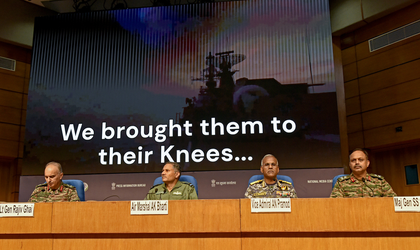India delivered ‘hellfire’ in precision strikes, Pak realised futility of escalation: Military sources
By IANS | Updated: May 12, 2025 19:32 IST2025-05-12T19:28:21+5:302025-05-12T19:32:41+5:30
New Delhi, May 12 India’s response to provocations from Pakistan was a carefully calibrated but forceful demonstration of ...

India delivered ‘hellfire’ in precision strikes, Pak realised futility of escalation: Military sources
New Delhi, May 12 India’s response to provocations from Pakistan was a carefully calibrated but forceful demonstration of its military and strategic superiority. The ‘Operation Sindoor’, included a series of high-precision air strikes that hit deep inside Pakistani territory, targeting key terror infrastructure and military-linked facilities.
The Indian Armed Forces conducted nine targeted strikes on the morning of May 7, marking a decisive shift in India’s counter-terror strategy. These were not aimed at peripheral camps or low-level assets. The targets struck were headquarters, major training hubs -- facilities that had long histories of fostering cross-border terrorism.
One of the core messages, sources said, was that no place is safe anymore for terror operatives or their supporters, even in Pakistan’s heartland.
“If you're operating from Lahore, Rawalpindi, or Muridke, you will be hit. We have changed the game, and that message has gone through,” the official added, referencing attacks on key locations such as Muridke, where funerals for terrorists had included attendance by senior Pakistani civilian and military officials -- underscoring the state's complicity.
On May 10, after a series of Pakistani provocations, including attempted drone incursions and artillery attacks across 26 locations, India retaliated with what military sources described as "hellfire".
Eight major Pakistani military facilities were hit by precision-guided munitions. Runway at one place was destroyed. Chaklala -- an installation near the Pakistani capital -- sustained what even their own defence officials privately admitted was severe damage,” a senior source confirmed.
India’s airstrikes exposed the ineffectiveness of Pakistan’s air defence systems, which reportedly failed to prevent or intercept any of the incoming Indian projectiles. “We struck at will, and at locations of our choosing. Their response was disorganized and largely ineffective,” officials said.
Pakistan retaliated with attempted strikes on 14–20 Indian locations, but most of these were successfully intercepted by India’s air defence systems. “There was some limited damage to satellite facilities, but none of the major bases or targets they claimed were hit suffered any serious impact. Their response fell well short of matching our capability or scale,” officials noted.
The comprehensive Indian response marked a new phase in military doctrine -- moving from restrained retaliation to strategic deterrence through overwhelming force. The strikes were intentionally designed to be non-escalatory, avoiding civilian and direct military targets while clearly emphasising a zero-tolerance stance on terrorism.
The military operation was reinforced by parallel efforts on the diplomatic front. Indian leaders, including the External Affairs Minister, NSA, communicated clearly with global counterparts: there can be no equivalence between the victim and the perpetrator.
India refused to accept traditional international calls for parity and restraint, pushing instead for clear condemnation of terrorism. At least a dozen nations publicly supported India’s right to self-defence, with many more expressing solidarity.
India also rejected any third-party shuttle diplomacy, unlike past crises. “There was no back-and-forth between capitals. We stood firm, independent, and communicated our position directly,” sources said, drawing a contrast with post-Parliament attack diplomacy in 2001–2002.
“That was the moment they realised they were outmatched -- they had no appetite for further escalation,” sources said bluntly. “This is not business as usual. We’ve drawn a red line. Terrorism will invite a cost -- military, political, and psychological,” a top military source concluded.
Disclaimer: This post has been auto-published from an agency feed without any modifications to the text and has not been reviewed by an editor
Open in app